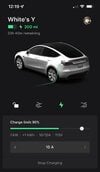Hey guys super noob here. Did some forum searching and i think i have the answer but thought i’d get the consensus.
Got my MY a week ago been using just the 115v in the garage overnight and its been normally at 4 kw/h (added 31 miles) last night 8 hrs. ( i know i’m switching metrics here) Anyway after a short trip this morn came back home and plugged in for the 2 hrs before leaving to work and was getting 0 kw/h but the time to full was still counting down. And counting down at a rate that would put me at 290 miles in 24 hrs. Which my crude math would be (4mi per hr like last night)
I gained only 2 miles in this two hr charge. Strange
My guess car sees the circuit cant take the 10A charge but still shows its charging at that but only maybe 1/2-1 kw/h.
Sorry for all the switching back and forth. My electricity background is i know how to let smoke out of the wires.
Thanks
Got my MY a week ago been using just the 115v in the garage overnight and its been normally at 4 kw/h (added 31 miles) last night 8 hrs. ( i know i’m switching metrics here) Anyway after a short trip this morn came back home and plugged in for the 2 hrs before leaving to work and was getting 0 kw/h but the time to full was still counting down. And counting down at a rate that would put me at 290 miles in 24 hrs. Which my crude math would be (4mi per hr like last night)
I gained only 2 miles in this two hr charge. Strange
My guess car sees the circuit cant take the 10A charge but still shows its charging at that but only maybe 1/2-1 kw/h.
Sorry for all the switching back and forth. My electricity background is i know how to let smoke out of the wires.
Thanks




